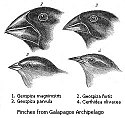Homologia (biologia)
Homologia (gr. homólogos ‘zgodny’) – wspólne ewolucyjne pochodzenie struktur (np. narządów) lub procesów fizjologicznych, występujących u różnych organizmów, wynikające z ich odziedziczenia po wspólnym przodku. W biologii wyróżnia się kilka typów homologii:
- Homologia międzygatunkowa (inaczej ortologia) – występuje u organizmów należących do różnych gatunków. Klasycznym przykładem takich struktur są: kończyna ssaków, płetwa ryb i skrzydło ptaka.
- Homologia polimorficzna – występuje u osobników w obrębie tego samego gatunku. Przykładem takich struktur są genitalia ssaków łożyskowych: prącie i łechtaczka, wargi sromowe mniejsze i napletek oraz wargi sromowe większe i moszna. Homologia polimorficzna ujawnia się także pomiędzy poszczególnymi kolonijnych organizmów klonalnych (np. mszywioły, stułbiopławy), jak również między różnymi kastami termitów i mrówek.
Zjawisko homologii może występować także w obrębie jednego organizmu. Wyróżnia się dwa takie zjawiska:
- Homologia seryjna – występuje pomiędzy poszczególnymi narządami u tego samego osobnika. Przykładem są: kręg szczytowy (dźwigacz) i kręg obrotowy, a także różne segmenty ciała stawonogów.
- Homologia ontogenetyczna – występuje pomiędzy poszczególnymi stadiami rozwoju osobniczego (ontogenezy). Przykładami są: meduza i polip, a także larwa, poczwarka i imago.
Zobacz też
Bibliografia
- Ewolucyjny sens homologii, [w:] Jerzy Dzik, Zoologia. Różnorodność i pokrewieństwa zwierząt, Warszawa: Wydawnictwa Uniwersytetu Warszawskiego, 2015, s. 9–10, ISBN 978-83-235-1918-8.
Media użyte na tej stronie
Darwin's finches or Galapagos finches. Darwin, 1845. Journal of researches into the natural history and geology of the countries visited during the voyage of H.M.S. Beagle round the world, under the Command of Capt. Fitz Roy, R.N. 2d edition.
- 1. (category) Geospiza magnirostris
- 2. (category) Geospiza fortis
- 3. Geospiza parvula, now (category) Camarhynchus parvulus
- 4. (category) Certhidea olivacea
Figure from Meyers Lexicon Conversion 1888 - Skeletons of mammalian hands.
From left to right: Orangutan ; Dog ; Swine ;Cattle; Tapir; Horse
Abbreviations: R, Radius; U, Ulna; A-G, Cc, P, carpals; A, Scaphoideum; B, lunar; C, "Triquetum"; D, trapezium; E, trapezoids; F, Capitatum; G, Hamatum; P, Pisiform; Cc, central carpal; M, metacarpal; 1-5, thumb and digits two to five.


